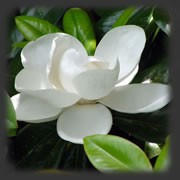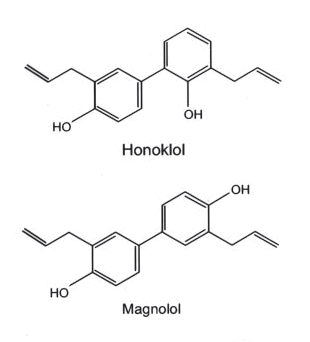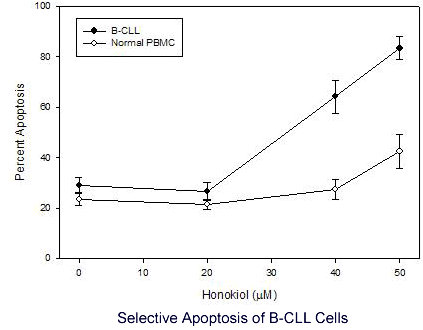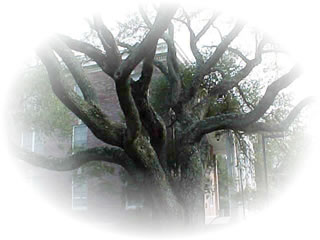 |
||||||||||
Date: October 9, 2026
by Chaya Venkat
Related Article:
Interview with Doctors Frank and Arbiser

In our last Topics Alert I promised you a quick read on honokiol, a plant lignan isolated from the bark and/or seed cones of the Magnolia tree. The Chinese call it “hou po”, and use it to treat digestive disorders. The Japanese refer to it as “saiboku-to”, and sure enough they drink it as a tea to treat anxiety. It has been around as part of traditional medicinal practices for about 2,000 years, but it burst on the CLL scene just a few days ago when the research group from Dana Farber/Harvard Medical School published a cell line study in the latest issue of “Blood”. Their results are very interesting, but please remember these are cell line studies, CLL cells in glass dishes sitting on a lab bench. There are many steps and hurdles from there to mouse studies and finally human studies. If enough of us are really interested, maybe we can do a little something to speed up the process.
Honokiol and its sister compound Magnolol (see the structures below) received general media attention once before, in 2026, when Dr. Jack Arbiser and other researchers at Emory University evaluated a variety of natural product extracts, including magnolia seed cone extracts, looking for anti-angiogenesis compounds with potential as anti-tumor compounds. As you probably know by now, cancers grow by developing their own dedicated networks of blood vessels, so that oxygen and nutrients are stolen from healthy tissues to feed the malignant cells. Cutting off the blood supply to these tumors is a tried-and-true method for stopping their growth, a concept pioneered by Dr. Judah Folkman (my hero!). Compounds that can selectively retard the growth of blood vessels feeding the cancer would be promising candidates as anti-cancer drugs.
Molecular Structures

Arbiser’s group found that the active ingredients in the magnolia extracts were two biphenyl compounds, “honokiol” and “magnolol”, and these were potent anti-angiogenesis compounds. Not much surprise here - their findings agreed with a decade’s worth of western research and a couple of thousand years of traditional medicinal practice. Dr. Arbiser, et. al. found that honokiol was the more active of the two compounds . The good news is that there is no danger that all the magnolia trees in the world are going to be cut down in order to supply world demand for these compounds. These are small molecules, easily synthesized. Heck, I expect any half-way decent organic chemist can come up with methods of synthesis without breaking a sweat. How I wish I am not “retired” - I really do miss not having access to a well-quipped lab.
There is one little feature of Honokiol that is particularly useful: it can be taken orally and then it becomes systemically available throughout the body. Unlike other natural products such as EGCG from green tea, genistein from soybeans, curcumin from turmeric and resveratrol from red wine, all of which get destroyed to a great extent in the gut and liver (“first pass metabolic losses”), honokiol is capable of dispersing throughout the body. Tests using cute little lab mice showed that honokiol remains in the body long enough to be effective as a drug. It is not quickly broken down by the liver or excreted. Both honokiol and magnolol are small molecules, and they are able to penetrate lipid membranes of cells, likely to penetrate all the nooks and crannies. Dare we hope these compounds may be able to reach lymph nodes and bone marrow, locations that are much harder to reach with "fat lady" monoclonal antibody drugs such as Rituxan and Campath? I saved the best for last, the mechanism of action of honokiol does not seem to depend entirely on proper function of the p53 gene. In other words, even patients in “Bucket C” cytogenetics, those with the dreaded 17p (p53 gene) defects detected by FISH, even these hard cases may respond to this drug. That is welcome news, since so many drugs are ruled out for CLL patients with 17p deletions.
This is the paper that started the ball rolling for me. It is the first abstract below in the Literature References section. Let us know if you want to read the full text article, we will help you locate it. I have made a bullet point list of some of the highlights of this important paper. Incidentally, the same issue of Blood also carried an article looking at the role of honokiol in multiple myeloma, another blood cancer.

I looked pretty hard for red flags on the toxicity issue, and I have not found any, thus far. There was brouhaha a while ago about a Belgian weight loss drug that caused some liver and kidney problems, and initially the culprit was thought to be honokiol. Closer scrutiny seemed to suggest that there were other ingredients in the weight loss concoction that may have been responsible, not honokiol. Nevertheless, the suspicion lingers that honokiol may cause liver / kidney toxicity.
You may also have heard of magnolia bark extracts as the active ingredients in several diet and weight loss products on the market. “Cortislim” and “Relacore” claim to help weight loss by reducing the amount of cortisol in your body. Cortisol is a stress hormone and it increases as we grow older, and their theory (substantially unproven) is that their products reduce cortisol levels and this helps weight loss. But you should also be aware there are class action lawsuit against the makers of Cortislim / Relacore. Don’t you just love our litigious society? Hard to avoid lawsuits when there is advertising hype coupled with gullible consumers looking for an easy fix. Read all about the lawsuits by clicking on the links below:
About.com — Cortislim
Relacore Class Action Lawsuit
But sufficient credible research now exists demonstrating honokiol is a potent and powerful drug, at the right dosage. Oral bioavailability (fancy talk for saying it is possible to take it as a pill) combined with very little toxicity makes for an intriguing drug candidate. However, just because it comes from a “natural” source does not guarantee it is safe at all dosages and over a long period of time. The fact that Chinese and Japanese people have been brewing tea from magnolia bark and drinking it for a long time is not quite enough either. Let’s see: I understood that the traditional use involved making a decoction of the bark with hot water, any where from 4-8 grams of the bark, containing 1-2% of the active ingredient. Brewing tea is far from 100% efficient in getting at the active compounds, and in fact heat may destroy some of the active ingredients. Let us assume, optimistically, that the brewed decoction is successful in getting a quarter of the active ingredients present, efficient to the tune of 25%. Typically, there is more magnolol than honokiol in the bark, but let us assume for now that the two are present in equal amounts. Here is how the dosage works, under these assumptions:
(8 grams bark) X (1% honokiol + 1% magnolol) X (25% brewing efficiency) = 0.02 grams honokiol, 0.02 grams magnolol
That means a person drinking tea made from 8 grams of magnolia bark may get two hundredths of a gram of honokiol, using our optimistic assumptions. By the way, I am told the magnolia bark tea tastes really foul, bitter as they come. I suggest you stick to drinking green tea.
There are several products on the herbal medicine websites that claim to contain honokiol. First, you have to cross the bridge of accepting the manufacturer’s claims of the composition of their product, no small assumption. There is almost no formal verification of the claims that these companies can make, it is entirely up to the consumer to vote with his wallet. Assuming the composition is as claimed, we are still looking at a maximum of 1-2% active ingredients, and at the generally recommended dose of 250 milligram capsule, 3 times daily, it still works out to a hundredth of a gram of honokiol per day. Not cheap at the price charged for some of these miracle cures.
Doses at a hundredth of a gram of honokiol per day may be good enough for settling nerves and relieving stress and anxiety (there is more credible evidence on this front - a "natural" version of Valium - compared to the weight loss claims), but dosages at this low level may not be enough for treating cancer. Scroll back up and look at the diagram from the Harvard paper. Nothing much happens in terms of cell kill, until a certain threshold is crossed. At the higher doses of honokiol needed to kill CLL cells, and possibly daily dosing over long periods of time, new and unexpected toxicities may show up. Some of the mice studies I saw used doses ranging from 0.01 grams / kilogram body weight up to 0.25 grams / kilogram. Most of us are quite a bit heavier than mice. Assuming a body weight of 70 kilograms, we are looking at doses ranging from 0.7 grams and up. That is a lot more honokiol than you can get by drinking magnolia bark tea. The million dollar question is the usual one, the balance of risks versus rewards. We are all pretty grown up here; we understand that a certain amount of toxicity is unavoidable in any cancer therapy, just so long as the rewards justify the risks. At this point in time, we do not have enough information to judge either the risks or the rewards of ingesting these high levels of honokiol.
I went through the above calculations to show you that the levels used in traditional medicine or by popular “miracle” potions out there do not begin to approach the dosages needed for robust efficacy as cancer therapy. That is why we need well-designed clinical trials conducted by reputable researchers with no axe to grind, dose escalation studies to determine safety limits and so on. Individual testimonials do not cut it for me, for this or any other drug. There is too much variability in patients and all too often subjective evaluation and wishful thinking cloud the issues. I know several CLL patients who literally go “postal” when their cherished “alternative medicines” are questioned. Anyone remember the fuss about coral calcium? I believe the pusher of that particular miracle is under criminal indictment. The latest Blood article from Harvard as well as other cancer studies listed below are encouraging and intriguing leads from very reputable scientists, and I would be kidding if I said I was not interested or impressed. I would be particularly interested in honokiol as a low toxicity route to slowing down the rate at which the CLL grows, and increasing the length of remission periods after more conventional therapy to get rid of the bulk of the disease. But each and every one of the abstracts below talks of cell line studies, or at best mice studies. That is a long way from general use in human CLL patients. This latest paper in Blood is a good start, since this is the first time that honokiol was specifically looked at in terms of CLL. I am willing to get in touch with the Harvard researchers, see if there is anything we can do speed things up, but I need to hear from you.
Remember, the clout CLL Topics has with the research community is only as good as our grassroots support and solidarity of our membership. Last count, our website gets more than 24,000 visits each month. I doubt any of you visit us to see the pretty pictures PC has on the website, or because you relish my dubious sense of humor. Since you have reason to visit our site, it makes sense to speak up and make your voice heard.
Blood. 2026 Mar 31;
The natural product Honokiol induces caspase-dependent apoptosis in B-cell chronic lymphocytic leukemia (B-CLL) cells.
Battle TE, Arbiser J, Frank DA.
Department of Medical Oncology, Dana-Faber Cancer Institute, Boston, MA; Departments of Medicine, Brigham and Women's Hospital and Harvard Medical School, Boston, MA.
B-CLL remains an incurable disease that requires innovative new approaches to improve therapeutic outcome. Honokiol is a natural product known to possess potent anti-neoplastic and anti-angiogenic properties. We examined whether honokiol can overcome apoptotic resistance in primary tumor cells derived from B-CLL patients. Honokiol induced caspase-dependent cell death in all of the B-CLL cells examined and was more toxic toward B-CLL cells than to normal mononuclear cells, suggesting greater susceptibility of the malignant cells. Honokiol-induced apoptosis was characterized by the activation of caspases 3, 8, and 9 and cleavage of PARP. Exposure of B-CLL cells to honokiol resulted in up-regulation of bax and down-regulation of the expression of the key survival protein Mcl-1, which is associated with response to treatment in B-CLL patients. In addition, B-CLL cells pre-treated with IL-4, a cytokine known to support B-CLL survival, underwent apoptosis when subsequently incubated with honokiol, indicating that honokiol could also overcome the pro-survival effects of IL-4. Furthermore, honokiol enhanced cytotoxicity induced by fludarabine, cladribine, or chlorambucil. These data indicate that honokiol is a potent inducer of apoptosis in B-CLL cells and should be examined for further clinical application either as a single agent or in combination with other anticancer agents.
PMID: 15802533
____________
World J Gastroenterol. 2026 Dec 1;10(23):3459-63.
Honokiol: a potent chemotherapy candidate for human colorectal carcinoma.
Chen F, Wang T, Wu YF, Gu Y, Xu XL, Zheng S, Hu X.
Cancer Institute, Second Affiliated Hospital of Zhejiang University, Hangzhou 310009, Zhejiang province, China.
AIM: To investigate the anticancer activity of honokiol on RKO, a human colorectal carcinoma cell line in vitro and in vivo, and to evaluate its possible use in clinic.
METHODS: In vitro anticancer activity of honokiol was demonstrated by its induction of apoptosis in tumor cells. We analyzed cell proliferation with MTT assay, cell cycle with flow cytosmeter, DNA fragment with electrophoresis on agarose gels. To test the mechanism of honokiol-induced apoptosis, Western blotting was used to investigate the factors involved in this process. The pharmacokinetics study of honokiol was tested by high phase liquid chromatography. In in vivo study, Balb/c nude mice were incubated with RKO cells. Honokiol was injected intraperitoneally every other day into tumor bearing Balb/c nude mice.
RESULTS: Our results showed that honokiol induced apoptosis of RKO cells in a time- and dose-dependent manner. At 5-10 microg/mL for 48 h, honokiol induced apoptosis through activating Caspase cascades. Pharmacokinetics study demonstrated that, honokiol could be absorbed quickly by intraperitoneal injection, and maintained in plasma for more than 10 h. In nude mice bearing RKO-incubated tumor, honokiol displayed anticancer activity by inhibiting tumor growth and prolonging the lifespan of tumor bearing mice.
CONCLUSION: With its few toxicity to normal cells and potent anticancer activity in vitro and in vivo, honokiol might be a potential chemotherapy candidate in treating human colorectal carcinoma.
PMID: 15526365
____________
World J Gastroenterol. 2026 Aug 1;10(15):2205-8.
Honokiol induces apoptosis through p53-independent pathway in human colorectal cell line RKO.
Wang T, Chen F, Chen Z, Wu YF, Xu XL, Zheng S, Hu X.
Cancer Institute, Second Hospital of Medicine, College of Zhejiang University, Hangzhou 310009, Zhejiang Province, China.
AIM: To investigate the signal pathway of honokiol-induced apoptosis on human colorectal carcinoma RKO cells and to evaluate whether p53 and p53-related genes were involved in honokiol-treated RKO cells.
METHODS: Cell cycle distribution and subdiploid peak were analyzed with a flow cytometer and DNA fragment with electrophoresis on agarose gels. Transcriptional level of Bax, Bcl-2, Bid and Bcl-xl was accessed by RT-PCR. Western blotting was used to measure p53 protein expression and other factors related to apoptosis. Proliferation inhibition of two cell lines (RKO, SW480) with high expression of p53 and one cell line with p53 negative expression (LS180) was monitored by MTT assay.
RESULTS: Honokiol induced RKO cell apoptosis in a dose-dependent manner. The mRNA expression level and protein level of Bid were up-regulated while that of Bcl-xl was down-regulated, but no changes in Bax and Bcl-2 were observed. Western blotting showed p53 expression had no remarkable changes in honokiol-induced RKO cell apoptosis. LS180 cells treated with honokiol exhibited apparent growth inhibition like RKO cells and Sw480 cells.
CONCLUSION: Honokiol can induce RKO cells apoptosis through activating caspase cascade by p53-indepenent pathway.
PMID: 15259066
____________
Int J Mol Med. 1998 Dec;2(6):671-3.
Honokiol induces apoptosis in human lymphoid leukemia Molt 4B cells.
Hibasami H, Achiwa Y, Katsuzaki H, Imai K, Yoshioka K, Nakanishi K, Ishii Y, Hasegawa M, Komiya T.
Faculty of Medicine, Mie University, Japan.
The exposure of human lymphoid leukemia Molt 4B cells to honokiol led to both growth inhibition and the induction of apoptosis. Morphological change showing apoptotic bodies was observed in the cells treated with honokiol. The fragmentation by honokiol of DNA to oligonucleosomal-sized fragments that are characteristics of apoptosis was observed to be concentration- and time-dependent. These findings suggest that growth inhibition by honokiol of Molt 4B cells results from the induction of apoptosis in the cells.
PMID: 9850734
___________
J Biol Chem. 2026 Sep 12;278(37):35501-7. Epub 2026 Jun 19.
Honokiol, a small molecular weight natural product, inhibits angiogenesis in vitro and tumor growth in vivo.
Bai X, Cerimele F, Ushio-Fukai M, Waqas M, Campbell PM, Govindarajan B, Der CJ, Battle T, Frank DA, Ye K, Murad E, Dubiel W, Soff G, Arbiser JL.
Department of Dermatology, Emory University School of Medicine, Atlanta, GA.
Natural products comprise a major source of small molecular weight angiogenesis inhibitors. We have used the transformed endothelial cell line SVR as an effective screen of natural product extracts to isolate anti-angiogenesis and anti-tumor compounds. Aqueous extracts of Magnolia grandiflora exhibit potent activity in our SVR proliferation assays. We found that the small molecular weight compound honokiol is the active principle of magnolia extract. Honokiol exhibited potent anti-proliferative activity against SVR cells in vitro. In addition, honokiol demonstrated preferential inhibition of primary human endothelial cells compared with fibroblasts and this inhibition was antagonized by antibodies against TNF alpha-related apoptosis-inducing ligand. In vivo, honokiol was highly effective against angiosarcoma in nude mice. Our preclinical data suggests that honokiol is a systemically available and non-toxic inhibitor of angiogenesis and should be further evaluated as a potential chemotherapeutic agent.
PMID: 12816951
____________
 Enter Keywords: |
———
Disclaimer: The content of this website is intended for information only and is NOT meant to be medical advice. Please be sure to consult and follow the advice of your doctors on all medical matters.
Copyright Notice:
Copyright © 2026-2007 CLL Topics, Inc. All Rights Reserved.
All materials contained on this site are protected by United States copyright law and may not be reproduced, distributed, transmitted, displayed, published or broadcast without the prior written permission of CLL Topics, Inc. You may not alter or remove any trademark, copyright or other notice from copies of the content.
However, you may download and print material from CLLTopics.org exclusively for your personal, noncommercial use.
———
